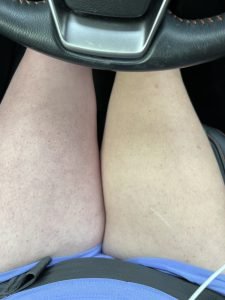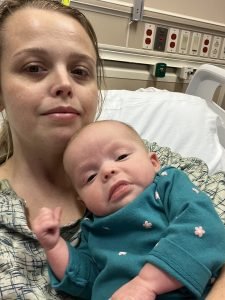Deep vein thrombosis (DVT) occurs when a blood clot forms in one or more of the deep veins in the body, usually in the legs. Deep vein thrombosis can be serious — and turn serious quickly — because blood clots in the veins can break loose. The clots can then travel through the bloodstream and get stuck in the lungs, blocking blood flow (pulmonary embolism). In November 2022, I had a DVT after pregnancy and C-section — this is my story.
It was a pretty typical Thursday morning. My husband was on a flight to Spokane, WA for the NACA West conference. Since I was home on maternity leave, I’d woken up and fed my daughter like any other morning.
But when I stood up to go wash out the bottle, I couldn’t bend my left leg; it was as though I’d just ran a marathon and my legs were locked up like I had a huge charley horse. I looked down, and my leg was a dusky purple. In a panic, I called my Direct Primary Care doctor at Health Studio KC and then FaceTimed my mom. Both told me to go the emergency room, pronto.

By the time I drove myself to the emergency room at the University of Kansas Medical Center, I couldn’t put weight on my leg or bend it, causing me to barely be able to push the stroller into the emergency room.
After an ultrasound and CT scan, the culprit was found: a blood clot located in a major vein in my pelvis. The room started to spin when I realized the weird left glute and lower back pain I’d felt for a week wasn’t a Pilates problem, it was a massive blood clot that somehow stayed put for a week and hadn’t triggered a pulmonary embolism.
Everything turned into a blur after that: my husband did an about-face as soon as he landed in Spokane and flew back to Kansas City. My best friend took the afternoon off of work to come to the hospital and take care of my daughter until my husband returned. I was admitted to the University of Kansas Hospital Center for Advanced Heart Care until I could have surgery the next morning.

The next morning I had a minimally invasive surgery to remove the blood clot called a thrombectomy with Dr. William Poulson, MD (whom I now trust with my life and highly recommend for vascular surgery). I was awake during the procedure, which was largely painless and uncomplicated. After another night in the hospital with a heparin drip, I was discharged from the hospital with a medically-mandated compression sock and Eliquis blood thinner prescription for 3-6 months.
You’re probably wondering: Why had this happened to me at around 2.5 months postpartum? I had five strikes against me: a recent C-section, a recent pregnancy, family history of blood clots, a blood clotting disorder called Factor V Leiden, and I’d recently started taking hormonal birth control. According to WebMD, some of the risk factors for DVT include:
- Recent pregnancy and childbirth
- Hospitalization and surgery
- Estrogen-based medications
- Injury and trauma
- Long periods of immobilization
If there’s one piece of advice I’d give anyone at risk for a DVT, especially women and mothers, it’s to listen to your doctors. I balked when my OBGYN said I shouldn’t take birth control because of the blood clot risk; my logic being that I’d never had an issue before, why would I get a blood clot now? My other nugget of advice is to not ignore a pain in your body: my left glute had bothered me for a week, my left leg for a couple days before I realized something was really wrong.
All in all, the experience taught me a sobering lesson: I am not invincible. My DVT experience tore down the armor and nearly blind arrogance that my 33-year-old body would never betray me in a single morning. I look at my health goals differently now: In 2023, I’ll be focusing less on weight loss and more on overall cardiovascular health and good nutrition.
















